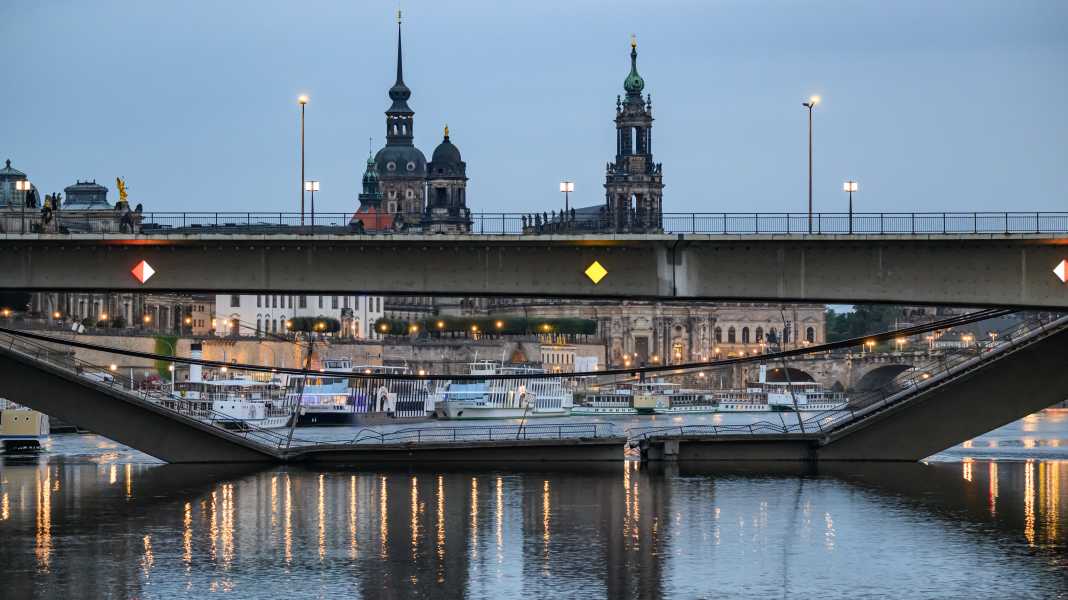
After two and a half years on the world's oceans, a Czech sailor was thwarted by the dilapidated Carola Bridge in Dresden. For 42 days, the 49-year-old anchored on the Elbe off Altkötzschenbroda because he was not allowed to pass under the bridge, which was in danger of collapsing. Late on Tuesday evening (11 March), he finally ventured onto the forbidden passage together with a Polish sailor - apparently with the tacit connivance of the authorities.
Months of suspension on the Elbe
The Czech man's sailing boat had been anchored since the end of January. According to his own statements, he had been in contact with the Federal Waterways and Shipping Administration (WSV) since October 2024. He was repeatedly told that it was too dangerous to pass through the Carola Bridge. "You cannot sail through the Carola Bridge," an email from the authority to the increasingly frustrated sailor allegedly read.
Driving through Carola Bridge at night despite a ban
On Tuesday evening at around 22:30, the Czech and a Polish sailor finally crossed the Carola Bridge. According to the Dresdner Neueste Nachrichten, the sailor is said to have been told by officials that it was merely an administrative offence. If he was prepared to pay 350 euros, they would look the other way. This information has not yet been confirmed by the authorities.
Two sailors pass the bridge
Passenger ships allowed to pass Carola Bridge
The impatience of the sailors was apparently fuelled by the fact that passenger ships were allowed to pass under the dilapidated bridge from 3 February in order to reach their shipyards. But without passengers. This is said to have been possible again at the end of February, but only for commercial vessels.
Passenger ships pass the bridge
Authorities in need of explanation
The sailor was spotted on the Elbe in Königstein on Wednesday morning. The deputy head of the Elbe Waterways and Shipping Office, Helko Fröhner, was still unaware of the incident in the morning: "This is beyond my knowledge," he explained. However, he conceded that the matter may well be known to the office. Fröhner initially did not want to comment on possible consequences. The facts of the case must first be clarified.
Questions about communication
The case raises questions about communication between water sports enthusiasts and the authorities. Why couldn't a solution be found for the passage of the Carola Bridge that took into account both safety concerns and the needs of the sailors? The months-long delay and the final night-time passage point to potential for improvement in the coordination between the parties involved.
Effects on water tourism
The closure of the Carola Bridge to water sports enthusiasts has potentially far-reaching consequences for water tourism on the Elbe. It remains to be seen whether the incident will lead to a review of the existing regulations and possibly to more flexible solutions.
Practical information:
Carola Bridge Dresden:
- Status: At acute risk of collapse
- Closure: Not passable for water sports enthusiasts
- Contact: Federal Waterways and Shipping Administration (WSV)
Legal information:
- Passage: Officially prohibited
- Consequences: Possible administrative offence
- Fine: Allegedly 350 euros (not officially confirmed)
The collapse of the Carola Bridge
On the night of 11 September 2024, an approximately 100-metre-long section of the Carola Bridge in Dresden was plunged into the Elbe. The collapse occurred shortly after 3 a.m., when fortunately nobody was travelling on the bridge. Just 18 minutes earlier, a tram had passed over the crossing. The exact cause of the collapse is still unclear. Holger Kalbe, the local head of the bridge and engineering structures department, made some initial assumptions: "There could have been a massive chloride ingress during the GDR era." Although chloride extraction had already been carried out on the structure in the past, there was a transport company mast at the demolition site, which may have led to concentrated chloride ingress. Another speculation concerns the damaged district heating pipe, which could have caused the bridge to vibrate and ultimately collapse.

